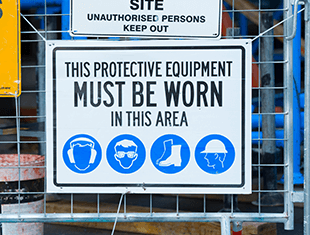9 Tips for Effective Safety Messaging to Prevent Common Injuries

Organizations are required under the OSHA General Duty clause to provide a working environment "free from recognized hazards that are causing or are likely to cause death or serious physical harm." Safety managers communicate hazards and take steps to prevent workplace injuries in an effort to abide by this clause. Some of the most common injuries are also the most preventable.
- Overexertion accounts for 34% of all workplace injuries
- 1 in 4 incidents involves contact with objects or equipment
- Slips, falls and trips cause 25% of work-related injuries
Simply delivering safety messages is not enough to guarantee that they are being heeded by employees. It is essential to capture employees' attention and encourage them to actively listen to and embrace safety practices. Here are 9 practical tips to help you effectively communicate safety messages and engage your employees in prioritizing safety.
- Make safety a priority: Create a culture of safety within your organization by prioritizing safety in all aspects of your business operations. When employees see that safety is a core value, they are more likely to take safety messages seriously.
- Lead by example: Actions speak louder than words. Ensure that management and supervisors lead by example and follow all safety protocols. This demonstrates that safety is everyone’s responsibility, from the top down.
-
 Clear and concise communication: When delivering safety messages, be clear, concise, and use simple language. Avoid technical jargon or complex explanations that may confuse employees. Use signs, labels, and floor markings to enhance understanding.
Clear and concise communication: When delivering safety messages, be clear, concise, and use simple language. Avoid technical jargon or complex explanations that may confuse employees. Use signs, labels, and floor markings to enhance understanding. - Repeat and reinforce: Repetition is key to ensuring that safety messages stick. Communicate safety messages through various channels such as team meetings, email updates, bulletin boards, and training sessions. Reinforce the importance of safety regularly to keep it at the forefront of employees' minds.
- Tailor messages to the audience: Different departments or teams may have specific safety concerns. Tailor your messages to address the unique risks and challenges faced by each group. Consider using real-life examples or case studies relevant to their work to make the messages more relatable.
- Engage employees: Involve employees in the safety process by encouraging them to provide input, suggestions, and feedback. Actively involve them in safety committees or groups to foster a sense of ownership and responsibility for their own safety and that of their colleagues.
- Provide training and resources: Ensure that employees receive proper training in safety procedures and have access to necessary resources, such as personal protective equipment (PPE) or safety manuals. Offer regular refresher courses and encourage employees to ask questions or seek clarification when needed.
- Recognize and reward safe behavior: Recognize and reward employees who consistently follow safety protocols and demonstrate safe behavior. This can be done through incentives, public acknowledgment, or even small rewards. Positive reinforcement encourages employees to continue prioritizing safety.
- Continuous improvement: Regularly assess and review your safety policies and procedures. Solicit feedback from employees and make necessary adjustments to address any gaps or concerns. Actively involve employees in identifying and implementing safety improvements.
Put it to Work
Implement these strategies to create an environment where safety becomes ingrained in daily operations, resulting in a safer and healthier workplace for everyone involved. Creating a culture of safety takes time and effort. Consistency, strong leadership, and active employee engagement improve workplace safety programs, which leads to fewer incidents, better productivity, and higher morale.
Related Resources

Tips From Fipps: It Pays to Be Safe, The Business Case for Workplace Safety
Workplace safety is not only crucial for protecting employees' well-being but also for the overall success of ...
Read
Tips from Fipps: Be Your Own Safety Superhero
Ensuring a safe and secure work environment is a shared responsibility that each one of us plays a crucial ...
Read.png)
Get the Most Out of Toolbox Talks: Workplace Safety and Communication
What Are Toolbox Talks? Toolbox Talks, short safety meetings typically held at the job site before the ...
Read.png)





